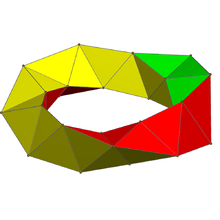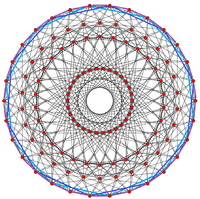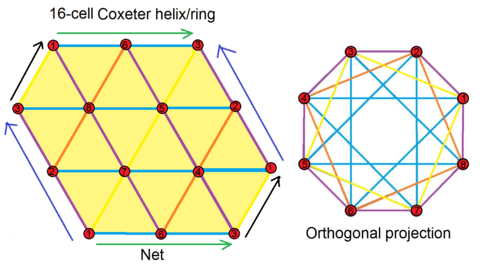Boerdijk–Coxeter helix
  |
| CCW and CW turning |
 Edges can be colored into 6 groups, 3 main helixes (cyan), with the concave edges forming a slow forward helixes (magenta), and two backwards helixes (yellow and orange) |

The Boerdijk–Coxeter helix, named after H. S. M. Coxeter and A. H. Boerdijk, is a linear stacking of regular tetrahedra, arranged so that the edges of the complex that belong to only one tetrahedron form three intertwined helices. There are two chiral forms, with either clockwise or counterclockwise windings. Contrary to any other stacking of Platonic solids, the Boerdijk–Coxeter helix is not rotationally repetitive. Even in an infinite string of stacked tetrahedra, no two tetrahedra will have the same orientation. This is because the helical pitch per cell is not a rational fraction of the circle.
Buckminster Fuller named it a tetrahelix and considered them with regular and irregular tetrahedral elements.[1]
Geometry
The coordinates of vertices of Boerdijk–Coxeter helix composed of tetrahedrons with unit edge length can be written in the form
where , , and is an arbitrary integer. The two different values of correspond to two chiral forms. All vertices are located on the cylinder with radius along z-axis. There is another inscribed cylinder with radius inside the helix.[2]
Architecture
The Art Tower Mito is based on a Boerdijk-Coxeter helix.
Higher-dimensional geometry

The 600-cell partitions into 20 rings of 30 tetrahedra, each a Boerdijk–Coxeter helix. When superimposed onto the 3-sphere curvature it becomes periodic, with a period of ten vertices, encompassing all 30 cells. The collective of such helices in the 600-cell represent a discrete Hopf fibration. While in 3 dimensions the edges are helices, in the imposed 3-sphere topology they are geodesics and have no torsion. They spiral around each other naturally due to the Hopf fibration.
In addition, the 16-cell partitions into two 8-tetrahedron rings, four edges long, and the 5-cell partitions into a single degenerate 5-tetrahedron ring.
| 4-polytope | Rings | Tetrahedra/ring | Cycle lengths | Net | Projection |
|---|---|---|---|---|---|
| 600-cell | 20 | 30 | 30, 103, 152 |  |  |
| 16-cell | 2 | 8 | 8, 8, 42 |  | |
| 5-cell | 1 | 5 | (5, 5), 5 |  | |
Related polyhedral helixes
Equilateral square pyramids can also be chained together as a helix, with two vertex configurations, 3.4.3.4 and 3.3.4.3.3.4. This helix exists as finite ring of 30 pyramids in a 4-dimensional polytope.
And equilateral pentagonal pyramids can be chained with 3 vertex configurations, 3.3.5, 3.5.3.5, and 3.3.3.5.3.3.5:
See also
Notes
References
- H.S.M. Coxeter, Regular Complex Polytopes, Cambridge University, 1974.
- A.H. Boerdijk, Philips Res. Rep. 7 (1952) 30
- The c-brass structure and the Boerdijk–Coxeter helix, E.A. Lord, S. Ranganathan, 2004, pp. 123–125
- Chiral Gold Nanowires with Boerdijk–Coxeter–Bernal Structure, Yihan Zhu, Jiating He, Cheng Shang, Xiaohe Miao, Jianfeng Huang, Zhipan Liu, Hongyu Chen and Yu Han, J. Am. Chem. Soc., 2014, 136 (36), pp 12746–12752
- Eric A. Lord, Alan Lindsay Mackay, Srinivasa Ranganathan, New geometries for new materials, p 64, sec 4.5 The Boerdijk–Coxeter helix
- J.F. Sadoc and N. Rivier, Boerdijk-Coxeter helix and biological helices The European Physical Journal B - Condensed Matter and Complex Systems, Volume 12, Number 2, 309-318, doi:10.1007/s100510051009
- Anthony Pugh (1976). Polyhedra: A visual approach. California: University of California Press Berkeley. ISBN 0-520-03056-7. Chapter 5: Joining polyhedra, 5.36 Tetrahelix p. 53


